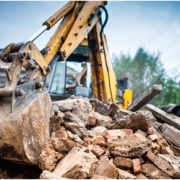What the regulations require and how to organize construction waste management
New construction, renovation, or demolition? In three paragraphs, I will explain what construction waste management entails, the regulations that apply, and how to organize yourself to comply without headaches.
What is CDW (construction and demolition waste)?
CDW is waste generated during construction, renovation, or demolition: concrete, brick, ceramics, wood, metals, plaster, soil, and rubble, among others. In Spain, its definition and management are regulated by Royal Decree 105/2008 and fall under Law 7/2022 and the EU Waste Framework Directive. Ministry of Ecological Transition
Sort properly from day one and you will save time and money.
Regulations: the essentials (Spain + EU)
- Spain – RD 105/2008 (CDW): defines who is the producer and owner of the waste, requires a study and management plan, and sets obligations for the construction site and waste manager. Ministry of Transport
- Law 7/2022: incorporates the circular economy, new traceability and taxation obligations (e.g., landfill/incineration tax), also applicable to CDW. BOE
- European Union: Directive 2008/98/EC and EU CDW Protocol (updated 2024) with guidelines for pre-demolition/renovation audits and confidence in recycled materials. Publications Office of the EU
Complying with the law is easier if you design the management plan before starting the project.
Practical process on site (simple and effective)
-
Before starting: include the CDW Management Study/Plan (expected flows, recovery, destination) in the project. Ministry of Transport
-
Segregation at source: separate containers (aggregates, metals, wood, plaster, mixtures), visible signage, and training for staff. Publications Office of the EU
-
Storage and safety: designated areas, dust/leachate control, photographic record and tracking sheets. BOE
-
Transport and authorized manager: contracts, weighing and transfer documentation; adjust frequencies to actual data, not emergencies. BOE
-
Priority recovery: apply the hierarchy prevent → reuse → recycle → recover → dispose (landfill only if there is no alternative). Environment
Common types of construction waste (and how to treat them)
- Soil and rubble: prioritize reuse on site or as recycled aggregate when it meets criteria.
- Concrete, brick, and ceramics: suitable for recycling as aggregate after crushing and screening.
- Metals (steel, aluminum, copper): high recovery value; segregate cleanly.
- Wood and plaster: separate for recycling; avoid contamination with paint/plaster in mixtures.
- Occasional hazardous waste (paints, solvents, asbestos*): specific management with an authorized manager and safety protocols. (Asbestos requires regulations and specialized companies).
Pre-demolition or renovation audit (your secret weapon)
The EU recommends conducting preliminary audits to identify reusable materials, hazards, and recovery routes before dismantling. This improves recycling rates and reduces cost surprises. Publications Office of the EU
Conclusion
Construction waste management is not just a “paper exercise”: it is planning + segregation + traceability to comply with regulations and save costs. If you plan ahead, position containers correctly, train your team, and work with authorized waste managers, performance improves and environmental impact decreases.





